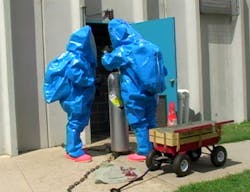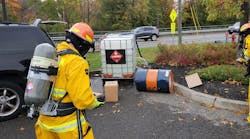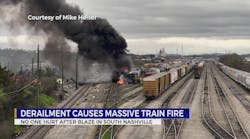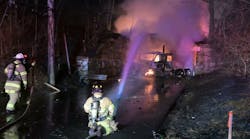According to the county’s official website, Sedgwick County was originally a camping ground of the Osage and Wichita tribes, later explored by Francisco Vázquez de Coronado and Christopher Houston “Kit” Carson. The area was settled in 1719 by M. DuTissenet, a Frenchman operating under the direction of the governor of Louisiana. DuTissenet brought with him soldiers, traders and hunters who soon populated and transformed the region from prairie to a land of opportunity.
Sedgwick County was officially established nearly 150 years later on Feb. 26, 1867, and bears the name of Civil War hero Major General John Sedgwick of the Union Army who was killed during the battle of Spotsylvania Courthouse in Virginia. In April 1870, the first county officials were elected, and Wichita was selected as the county seat.
Since then, the county has steadily grown to include 20 cities, Wichita being the largest. According to the 2010 census, the population was 498,365, making it the second most populous county in Kansas. Further, the county has a total area of 1,009 square miles, of which 998 square miles is land and 11 square miles is water.
Sedgwick County is one of many areas of the country with the potential for a variety of hazardous materials challenges. Following is a look at how Sedgwick County prepares for hazmat incidents.
SCFD, Then & Now
The Sedgwick County Fire Department (SCFD), officially known as Sedgwick Fire District Number 1, became fully paid in January 1955 with four stations. Before that time, fire protection in the county was limited to volunteer departments that were initially formed to protect the area’s wooden bridges.
Fire protection in the county prior to 1955 was very limited. Three Sedgwick County firefighters have lost their lives in the line of duty: Gerald Lee Lloyd (1973), responding to a fire when his tender was involved in an accident; Todd David Colton (1990), from heat exhaustion while fighting a brush fire; and Lieutenant Byron Wayne Johnson (2007), electrocuted while fighting a brush fire.
Today the SCFD has nine fire stations and operates under the command of Chief Tavis Leake. There are 137 uniformed personnel on the department, with 44 on duty each shift. Firefighters work 24/48 hours shifts. Firefighters cover approximately 691 square miles within the county. Several smaller cities in the county provide primary fire protection to their jurisdictions and are backed up by the SCFD when requested.
In 2014 SCFD personnel responded to 9,183 calls. Of those 4,397 were EMS (BLS), 482 were vehicle accidents, 85 were vehicle extrications, and the rest were fires, hazmat-related incidents and service calls.
The SCFD operates five engine companies, three quints, eight tenders, six squads (BLS medical calls first responder), four brush trucks, one heavy rescue, one air/light unit, one hazmat unit and two boats. The department also operates hazmat and technical rescue teams (TRT). Rescue includes confined space, high-angle, swiftwater, trench, building collapse and SCUBA. They respond jointly with their counterparts from the Wichita Fire Department.
EMS ALS is provided by the county but is not part of the fire department. The fire department does house some of the ALS units in their stations.
Hazmat Station 34
Built in 2014, Station 34 is the SCFD’s hazmat station (HM34), located at 334 N. Main St. in Haysville, KS. HMU has a first-response area of 91 square miles of urban and rural areas.
Sedgwick County's HMU can respond as a standalone unit or as part of a Hazardous Materials Response Team (HMRT). Also known as the Task Force, this group is composed of County Unit HM34, Wichita Fire Department units and McConnell Air Force Base (MAFB) units. The McConnell Air Force Base responds on request to all Level 3 (or higher) hazmat incidents. Further, technical support is provided by the Wichita Environmental Health Department and Sedgwick County Emergency Management. If additional resources are needed, mutual aid is available from the Salina (KS) Regional Hazardous Materials Team.
Hazmat Response
Hazardous materials response in Sedgwick County became a concept in 1980 and was formally established in 1984 with all hazmat team members assigned to one station. The mission of the team is to handle the emergency side of chemical releases and weapons of mass destruction (WMD) responses.
Hazmat responses by Sedgwick County and the Wichita Fire Department are based on four levels:
- Level 1: Incident can be handled by first-arriving units and requires only hazmat operations-level trained personnel.
- Level 2: Incident is beyond the capabilities of operations-level trained personnel; in addition to the first-arriving operations-level unit, it requires one unit from the HMRT.
- Level 3: Incident is beyond the capabilities of a single HMRT unit and requires a full HMRT response.
- Level 4: Incident is a response to white powder (anthrax threats or scares). This is the same as a Level 1 unless it is deemed to be a credible threat at which time it will be upgraded to a Level 3 incident.
Sedgwick County's HMRT is not dedicated; personnel at Station 34 staff the hazmat unit but also respond with other apparatus to fire, medical, rescue and service calls. Countywide there are 20 trained hazmat technicians on the department.
A minimum of five hazardous materials technicians are on duty at all times, and all other firefighters in the county are trained to the operations level. The balance of technician-level personnel needed for a response are assigned to Wichita Station 10 and respond with Wichita units. That department has 50 department members trained to the technician level.
SCFD also operates under an agreement with the Kansas State Fire Marshal's Office and will deploy to hazardous materials incidents anywhere in the state of Kansas when requested. It will send a minimum of five technician-level personnel and one person from Sedgwick County Emergency Management as a liaison with the local jurisdiction.
In 2014 there were 79 hazmat responses by the SCFD. Of those, 24 required the response of the HMRT task force. Incidents also included fuel spills, gas odors and leaks. Engine and quint companies carry absorbent materials, as does County Health Department Hazmat 99. Spills of more than 25 gallons require the response of the hazmat unit.
Foams carried by county units include Phos-Chek Class A and AR-AFFF Class B. These units employ a CAFS application system along with a FoamPro system using Class A and B.
All SCFD front-line pumping apparatus are equipped with Class A and B foam systems. Some carry CAFS systems as well. Extra foam supplies are stored at the department’s headquarter offices. Further, the McConnell Air Force Base Fire Department has additional foam available through mutual aid. Also through mutual aid, the Wichita Airport and McConnell Air Force Base have airport crash trucks that are available to respond as needed.
Apparatus: HM34 Specs
HM34 was paid for by Homeland Security funds and is required to provide WMD response to 19 additional counties: Barber, Barton, Butler, Comanche, Cowley, Edwards, Harper, Harvey, Kingman, Kiowa, Marion, McPherson, Pawnee, Pratt, Reno, Rice, Stafford and Sumner.
The unit is built on a 2012 Spartan Gladiator chassis, and the body was built by SVI in Fort Collins, CO. It is powered by a 380-hp Cummins diesel engine coupled with an Allison transmission. The unit is 36 feet long and 12 feet wide and includes a slide-out work area that expands the size of the command center. Also on the unit is a 10-kW PTO generator to supply electrical needs and the light tower.
Respiratory protection carried includes Scott NxG7 4.5 SCBA with 45-minute air bottles. Mobile Air 32 carries six 6,000-psi bottles combined with 35–40 extra prefilled air bottles. An onboard compressor is used for refilling empty air bottles. Station 37 has a Supplied Air Respirators (SAR) cart, which provides air to four individuals with 300 feet of hose.
PPE includes Level A Trelleborg-Trellchem VPS, Level A Kappler 41550 and Level B Kappler CPF2 chemical protective suits. In-suit communication is provided by Motorola Voiceducer push-to-talk earpieces used in conjunction with Motorola XTS5000R radios.
Decontamination is conducted with typical equipment and supplies including wet/dry capability and a decontamination tent.
HR34 carries a variety of monitoring instruments:
- Thermo Scientific AhuraFD (various liquid and solid products)
- Smiths Detection HazMatID 360 (multiple gases)
- RAE Systems ppbRAE Plus (volatile organic compounds), MultiRAE (O2, H2S, VOC, LEL, CO), AreaRAE (O2, H2S, LEL, CO)
- FLIR’s identiFINDER (radiation)
- W.B. Johnson & Associates RAD Dual Probe Meter (Alpha, Beta, Gamma rays)
- RKI Eagle multi-gas detector
- Coastal Environmental Systems Inc. C-5 SAM Weather Station
- M8 and M9 paper (chemical agent detector)
- M256 chemical agent detector kit (nerve/blister agents)
- BioCheck 20/20 Powder Screening Test Kit
HR34 also carries a field screening kit that does not test for specific materials but rather identifies physical and chemical properties of a material.
HR34 carries many research resources as well:
- Emergency Response Guidebook (ERG)
- U.S. Coast Guard Chemical Hazards Response Information System (CHRIS) manuals
- NIOSH Pocket Guide to Chemical Hazards
- Sax's Dangerous Properties of Industrial Materials
- Emergency Handling of Hazardous Materials in Surface Transportation
- Crop Protection Handbook
- Department-specific Industrial Chemical Safety Manual
- The Merck Index
- Hazardous Chemicals Desk Reference
- Tier II reports for county
- Managing Hazardous Materials Incident
- Draeger Tube Handbook
- Eagle Manual and Correction Factor Book, Relative Response Factors
All personnel assigned to the hazmat team receive the International Fire Service Accreditation Congress (IFSAC) Hazmat Technician Level certification. Additional training includes the National Fire Academy Chemistry for Emergency Response, Operating Site Practices and Hazardous Materials Incident Management. Courses including specific areas of Weapons of Mass Destruction (WMD) response, radiation detection and integrated command are also provided to personnel.
Transportation routes within Sedgwick County include U.S. 55, Interstate 35 and the Kansas Turnpike. The Burlington Northern Santa Fe (BNSF) and Union Pacific have rail lines within the county. Additionally, fixed facility exposures include aircraft plants, a chlorine facility with 1 million pounds of chlorine on site and 400-plus Tier II facilities. Propane, anhydrous ammonia, and pesticides are located at various facilities throughout the county.
SCFD Contacts
For additional information about the Sedgwick County Hazardous Materials Response Team, contact Capt. Kevin Nelson, (301) 461-6707; Capt. Sam Konkel, (316) 641-6671; or Division Chief Stewart Segraves, (316) 640-3851.






